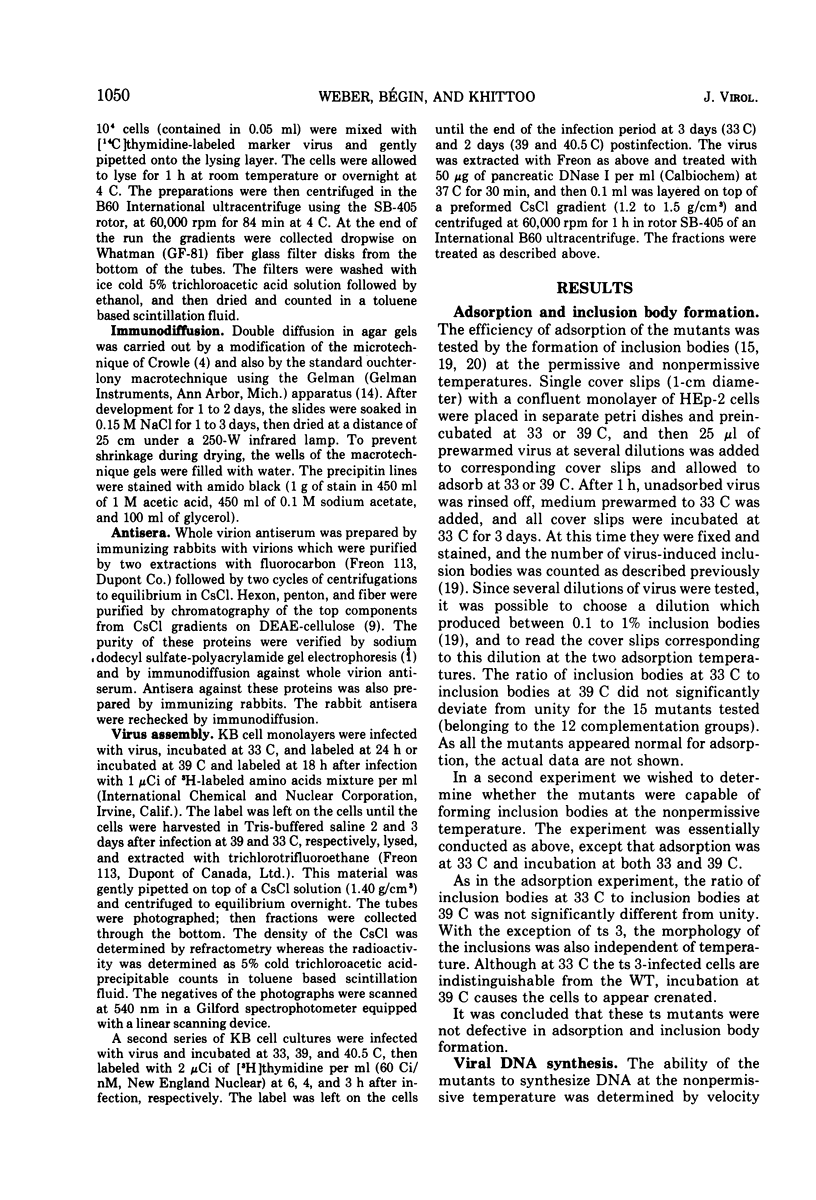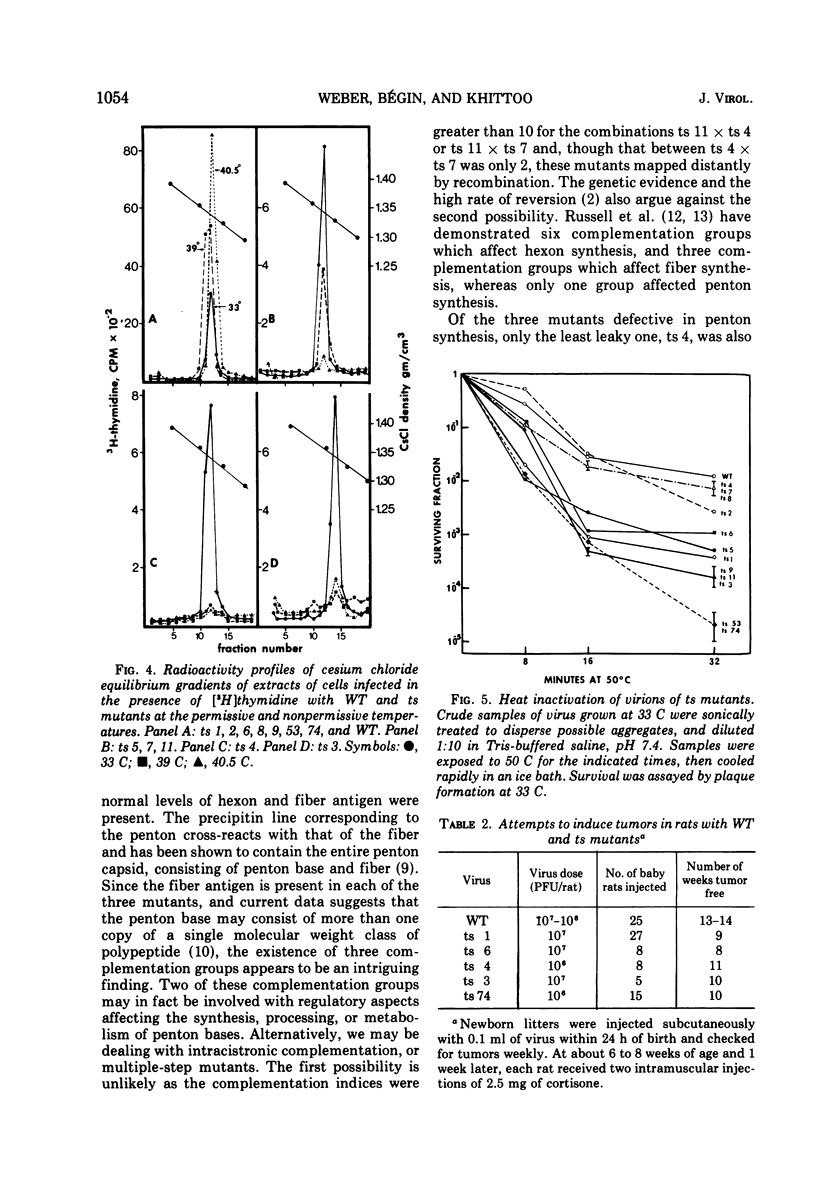Abstract
The properties of temperature-sensitive mutants of adenovirus type 2 representing 12 complementation groups were studied. All mutants were normal with respect to adsorption as measured by viral inclusion formation and viral DNA synthesis as shown by velocity sedimentation in alkaline sucrose gradients. One mutant, however, formed viral inclusions of altered morphology at the nonpermissive temperature. The synthesis of the major capsid proteins was examined by immunodiffusion. On this basis, the complementation groups could be arranged as follows: (i) one group was negative for all three proteins; (ii) three groups failed to synthesize penton bases; (iii) eight groups were positive for hexons, pentons, and fibers. The assembly of virus particles at 39 C was examined by equilibrium sedimentation in CsCl; three groups were found defective, whereas two of the penton-negative groups were positive for virion production. Tests of the thermolability of virions at 50 C revealed eight groups labile whereas the remainder were insensitive to heat inactivation. None of five mutants inoculated in newborn rats induced tumors, although three of them were capable of in vitro transformation.
Full text
PDF







Images in this article
Selected References
These references are in PubMed. This may not be the complete list of references from this article.
- Anderson C. W., Baum P. R., Gesteland R. F. Processing of adenovirus 2-induced proteins. J Virol. 1973 Aug;12(2):241–252. doi: 10.1128/jvi.12.2.241-252.1973. [DOI] [PMC free article] [PubMed] [Google Scholar]
- Burlingham B. T., Brown D. T., Doerfler W. Incomplete particles of adenovirus. I. Characteristics of the DNA associated with incomplete adenovirions of types 2 and 12. Virology. 1974 Aug;60(2):419–430. doi: 10.1016/0042-6822(74)90336-5. [DOI] [PubMed] [Google Scholar]
- Bégin M., Weber J. Genetic analysis of adenovirus type 2. I. Isolation and genetic characterization of temperature-sensitive mutants. J Virol. 1975 Jan;15(1):1–7. doi: 10.1128/jvi.15.1.1-7.1975. [DOI] [PMC free article] [PubMed] [Google Scholar]
- CROWLE A. J. A simplified micro double-diffusion agar precipitin technique. J Lab Clin Med. 1958 Nov;52(5):784–787. [PubMed] [Google Scholar]
- Doerfler W. Nonproductive infection of baby hamster kidney cells (BHK21) with adenovirus type 12. Virology. 1969 Aug;38(4):587–606. doi: 10.1016/0042-6822(69)90179-2. [DOI] [PubMed] [Google Scholar]
- Gallimore P. H. Tumour production in immunosuppressed rats with cells transformed in vitro by adenovirus type 2. J Gen Virol. 1972 Jul;16(1):99–102. doi: 10.1099/0022-1317-16-1-99. [DOI] [PubMed] [Google Scholar]
- Ginsberg H. S., Williams J. F., Doerfler W. H., Shimojo H. Proposed nomenclature for mutants of adenoviruses. J Virol. 1973 Sep;12(3):663–664. doi: 10.1128/jvi.12.3.663-664.1973. [DOI] [PMC free article] [PubMed] [Google Scholar]
- PEREIRA H. G. Antigenic structure of non-infectious adenovirus materials. Nature. 1960 May 14;186:571–572. doi: 10.1038/186571a0. [DOI] [PubMed] [Google Scholar]
- Philipson L., Pettersson U. Structure and function of virion proteins of adenoviruses. Prog Exp Tumor Res. 1973;18:1–55. doi: 10.1159/000393160. [DOI] [PubMed] [Google Scholar]
- Prage L., Pettersson U., Höglund S., Lonberg-Holm K., Philipson L. Structural proteins of adenoviruses. IV. Sequential degradation of the adenovirus type 2 virion. Virology. 1970 Oct;42(2):341–358. doi: 10.1016/0042-6822(70)90278-3. [DOI] [PubMed] [Google Scholar]
- Russel W. C., Newman C., Williams J. F. Characterization of temperature-sensitive mutants of adenovirus type 5--serology. J Gen Virol. 1972 Dec;17(3):265–279. doi: 10.1099/0022-1317-17-3-265. [DOI] [PubMed] [Google Scholar]
- Russell W. C., Skehel J. J., Williams J. F. Characterization of temperature-sensitive mutants of adenovirus type 5: synthesis of polypeptides in infected cells. J Gen Virol. 1974 Aug;24(2):247–259. doi: 10.1099/0022-1317-24-2-247. [DOI] [PubMed] [Google Scholar]
- Shahrabadi M. S., Roy K. L., Yamamoto T. Macromolecular content of inclusions produced by a canine adenovirus. J Virol. 1972 Oct;10(4):801–809. doi: 10.1128/jvi.10.4.801-809.1972. [DOI] [PMC free article] [PubMed] [Google Scholar]
- Shiroki K., Shimojo H., Yamaguchi K. The viral DNA replication complex of adenovirus 12. Virology. 1974 Jul;60(1):192–199. doi: 10.1016/0042-6822(74)90376-6. [DOI] [PubMed] [Google Scholar]
- Sundquist B., Everitt E., Philipson L., Hoglund S. Assembly of adenoviruses. J Virol. 1973 Mar;11(3):449–459. doi: 10.1128/jvi.11.3.449-459.1973. [DOI] [PMC free article] [PubMed] [Google Scholar]
- Suzuki E., Shimojo H., Moritsugu Y. Isolation and a preliminary characterization of temperature-sensitive mutants of adenovirus 31. Virology. 1972 Aug;49(2):426–438. doi: 10.1016/0042-6822(72)90495-3. [DOI] [PubMed] [Google Scholar]
- Weber J., Stich H. F. Electron microscopy of cells infected with adenovirus type 2. J Virol. 1969 Feb;3(2):198–204. doi: 10.1128/jvi.3.2.198-204.1969. [DOI] [PMC free article] [PubMed] [Google Scholar]
- Weber J. Titration of adenovirus by counting cells containing virus-induced inclusion bodies. Appl Microbiol. 1972 May;23(5):1025–1026. doi: 10.1128/am.23.5.1025-1026.1972. [DOI] [PMC free article] [PubMed] [Google Scholar]



